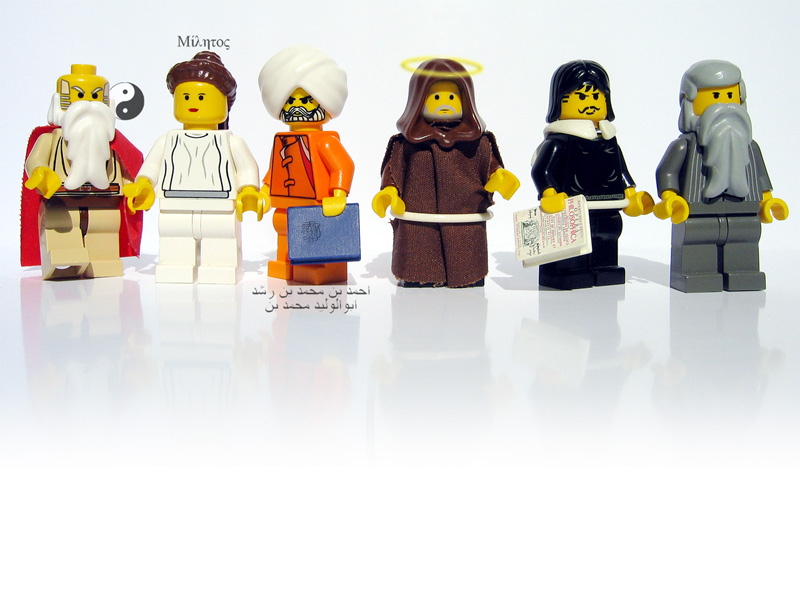
| Please visit the other 'Bricks' blogs: |
|
Sunday, May 31, 2009
Philosophers
Markus Lütkemeyer presents several philosophers from several different faith (and non-faith) traditions. From left to right we see Lao Tzu, Aspasia, Averroes, Saint Thomas Aquinas, Descartes and Karl Marx. At least the first, third and fourth are associated with specific religious traditions (Taoism, Islam and Christianity). Marx is, of course, atheist. There is some debate on Descartes true beliefs. BTW, I found this illustrating a parable. To me this is sort of like a LEGO version of that coexist bumper sticker.


Saturday, May 30, 2009
Pyramid scheme
Shannon Young objects to prosyletization, particularly the door-to-door kind, which he likens to a cosmic pyramid scheme. Be sure to follow that link to read his whole essay, illustrated with LEGO.


Friday, May 29, 2009
Crescent moon
Mister oo7 built the Palace of Sheikh Al-Ahmar Ibn Sihr. Now, as far as I can tell, this is a completely fictional building and is not a religious structure. So why did I include it here? Mainly because of the clever detail of the crescent moon on top of the central dome. The crescent moon, often accompanied by a star, has become a symbol of Islam. This may be because in pre-Islamic times the crescent was a symbol of both Persian and Ottoman empires, both of which later became dominated by Islam. The crescent often appears in architecture and flags associated with Islam. BTW, I've found this linked on what appears to be an Islamic blog. It's great to see LEGO creations getting notice outside of the circle of hobbyists.
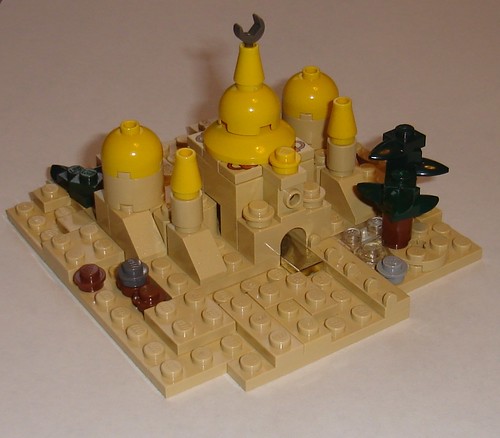





Thursday, May 28, 2009
Cathedral of St. Macário
Romão Santos has been working on his Cathedral of St. Macário for over two years. This is not based on a particular cathedral, but is an original design based on studying gothic architecture. If you check out his Brickshelf gallery you can see many in-progress pictures and also his other LEGO creations
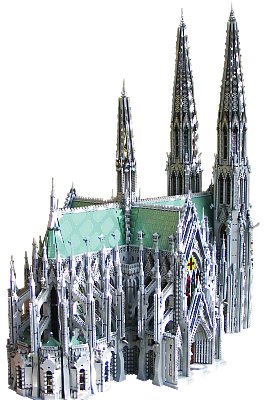

Wednesday, May 27, 2009
WWJB?
I wrote this in response to a question on a Christian forum about what sorts of LEGO God would want us to build. That discussion went down a lot of unhelpful rabbit trails, starting with some argument about whether Star Wars (the Force) and Harry Potter (witchcraft) were evil, but I was intrigued by the initial question. Some people responded with thoughts of "LEGO is just a toy - it doesn't matter - God doesn't care - why would someone even raise the question?" I thought a little differently and wrote the thoughts below. Remember, this was written in a specifically Christian setting to a (presumably) Christian audience, so certain assumptions come along with that discussion. I'd be interested in hearing others' thoughts (and please, no running down rabbit trails about the Force and witchcraft and ending up in a completely unrelated argument about creationism or the sexual scandals involving Catholic priests) (that's what the aforementioned discussion ended up as, BTW).
In thinking about what a Christian should, or should not, do with LEGO, I start with the assumption that LEGO is (or at least can be) a form of art. It seems obvious that some art can be done to the glory of God - think of the ceiling of the Sistine Chapel, or the great Gothic cathedrals, or Handel's Messiah. These are all explicitly pointing to God. I think we can go beyond specifically religious subject matter, though. In discussing what it means to be a Christian author, Madeline L'Engle writes "to paint a picture or to write a story or to compose a song is an incarnational activity."1 Tolkien writes that the role of an author (and, we can assume, other artists (especially since he expands the metaphor to a painter in "Leaf by Niggle")) is to act as a sub-creator.2 The artist can be "inspired", that is, follow the leading of the Spirit, in a way that adds to creation and lifts the human condition. In addition to art that is sacred, it also seems obvious that some art can be profane. Some artists specifically set out to offend religious sensibilities (think, for instance, of the artist who put a crucifix in a jar of urine). An idol is another instance of profane art. I'd go further to say that any art that sets out to degrade people could also fall in this category (people being made in God's image). What is more questionable, perhaps, is if there is art that is neutral—neither sacred nor profane. We are told to do all things to the glory of God (e.g. 1 Cor 10:31), but some actions seem pretty neutral. For instance, I just scratched the tip of my nose while writing this. I cannot see what import that action has one way or the other. The same can be said of much art. I'm not sure what we could say one way or the other about a still life of a bowl of fruit, for instance.
Turning back to LEGO, I think most things that people build fall into this third, neutral category, whether it be a spaceship, a castle, or a train. So I really wouldn't worry from a negative standpoint about what you're building being offensive to God. Perhaps we should put more thought, though, in the other direction. "All things are lawful, but not all things edify." (1 Cor 10, again) If the central fact of our existence is our love for God, how is that reflected in our hobby? By this I don't just mean we should be building little crosses out of LEGO or illustrations of Bible stories, but are we following the leading of the Spirit in what we do? Is there a way that my most recent MOC can somehow add beauty to creation or lift up our eyes to something higher? It is, I suppose, a twist on the WWJD idea - what would Jesus build? It's probably a good challenge to us all.
Just to add a quick note from a different perspective, this blog post encourages Muslim parents to "Play like the Prophet" - that is, to encourage their children to play in ways that Muhammad would as part of making their faith real to them. They specifically note running, swimming and wrestling, as I gather there are references to Muhammad doing those things during his life. Muslim LEGO builders may ask themselves how their building might reflect their beliefs. For instance, I might assume that they would be less likely to do representations of people.
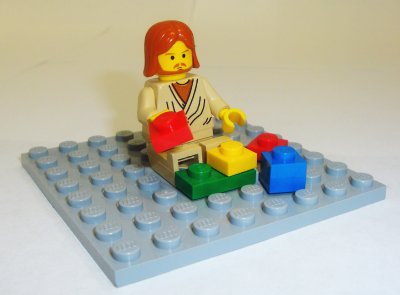
1From Madeline L'Engle Walking on Water: Reflections on Faith and Art - the whole book is an extended essay in response to a question she got from a student about what it means to be a Christian author.
2He develops this idea in various places (e.g. in his letters), but it is easiest to find in the essay "On Fairy-Stories," originally in Essays Presented to Charles Williams, but reprinted in both Tree and Leaf and The Tolkien Reader, which may be easier to find.
In thinking about what a Christian should, or should not, do with LEGO, I start with the assumption that LEGO is (or at least can be) a form of art. It seems obvious that some art can be done to the glory of God - think of the ceiling of the Sistine Chapel, or the great Gothic cathedrals, or Handel's Messiah. These are all explicitly pointing to God. I think we can go beyond specifically religious subject matter, though. In discussing what it means to be a Christian author, Madeline L'Engle writes "to paint a picture or to write a story or to compose a song is an incarnational activity."1 Tolkien writes that the role of an author (and, we can assume, other artists (especially since he expands the metaphor to a painter in "Leaf by Niggle")) is to act as a sub-creator.2 The artist can be "inspired", that is, follow the leading of the Spirit, in a way that adds to creation and lifts the human condition. In addition to art that is sacred, it also seems obvious that some art can be profane. Some artists specifically set out to offend religious sensibilities (think, for instance, of the artist who put a crucifix in a jar of urine). An idol is another instance of profane art. I'd go further to say that any art that sets out to degrade people could also fall in this category (people being made in God's image). What is more questionable, perhaps, is if there is art that is neutral—neither sacred nor profane. We are told to do all things to the glory of God (e.g. 1 Cor 10:31), but some actions seem pretty neutral. For instance, I just scratched the tip of my nose while writing this. I cannot see what import that action has one way or the other. The same can be said of much art. I'm not sure what we could say one way or the other about a still life of a bowl of fruit, for instance.
Turning back to LEGO, I think most things that people build fall into this third, neutral category, whether it be a spaceship, a castle, or a train. So I really wouldn't worry from a negative standpoint about what you're building being offensive to God. Perhaps we should put more thought, though, in the other direction. "All things are lawful, but not all things edify." (1 Cor 10, again) If the central fact of our existence is our love for God, how is that reflected in our hobby? By this I don't just mean we should be building little crosses out of LEGO or illustrations of Bible stories, but are we following the leading of the Spirit in what we do? Is there a way that my most recent MOC can somehow add beauty to creation or lift up our eyes to something higher? It is, I suppose, a twist on the WWJD idea - what would Jesus build? It's probably a good challenge to us all.
Just to add a quick note from a different perspective, this blog post encourages Muslim parents to "Play like the Prophet" - that is, to encourage their children to play in ways that Muhammad would as part of making their faith real to them. They specifically note running, swimming and wrestling, as I gather there are references to Muhammad doing those things during his life. Muslim LEGO builders may ask themselves how their building might reflect their beliefs. For instance, I might assume that they would be less likely to do representations of people.

1From Madeline L'Engle Walking on Water: Reflections on Faith and Art - the whole book is an extended essay in response to a question she got from a student about what it means to be a Christian author.
2He develops this idea in various places (e.g. in his letters), but it is easiest to find in the essay "On Fairy-Stories," originally in Essays Presented to Charles Williams, but reprinted in both Tree and Leaf and The Tolkien Reader, which may be easier to find.
Tuesday, May 26, 2009
Dome of the Rock
Jerusalem is a contentious area in part because it is a sacred site to the world's three major monotheistic religions. To Jews it is the site of the ancient Temple, to be rebuilt again in a messianic age. To Christians it is the site of Jesus' death and resurrection and other important events in his life and the life of the church. To Muslims it is the point from which Muhammad ascended into Heaven accompanied by the angel Gabriel. According to tradition, in 620 he stepped off from a rock on the Temple Mount to begin his miraculous journey. Between 685 and 691, the Dome of the Rock was built at this location, and is one of the holiest shrines in Islam. Arthur Gugick recreated this building in LEGO. Look close to check out the attention to detail. Among other things, this MOC graced the cover of the winter 2008 edition of BrickJournal.


Saturday, May 23, 2009
Official LEGO sets with religious content
This is a combination of three different blog posts: official sets, more official sets and still more official sets.
It seems that LEGO has decided to steer clear of official sets touching on religious themes. I suppose this is because they are an international company seeking to sell to people from all different faith communities and do not wish to offend anyone. Personally I think that's sad - faith is such an important part of the human experience and has had such a prominent role in the development of societies that it seems a glaring lack in, say, their Town, Castle, and Wild West themes. This hasn't always been so. Back in 1957 and 1958 they released two sets, both called "church" or "kirche", 309 and 1309. These are pretty much the same set, except in one the printed brick says "1762" and in the other it says either "ANNO 1762" or "AD 1762". The construction is pretty simplistic and so these sets probably would not be of interest to the modern LEGO fan, except maybe for the square windows and old-style trees that haven't been produced in 30+ years. I can't find any significance to the year 1762. Does anyone have a clue to this? Maybe there is a prominent church in Denmark that was built in that year?
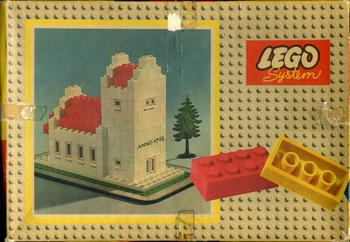
The one way that LEGO may get over their avoidance of religious themes is to go with architecturally significant landmarks that have huge cultural importance in addition to a religious sense. One such is the recent Taj Mahal set.
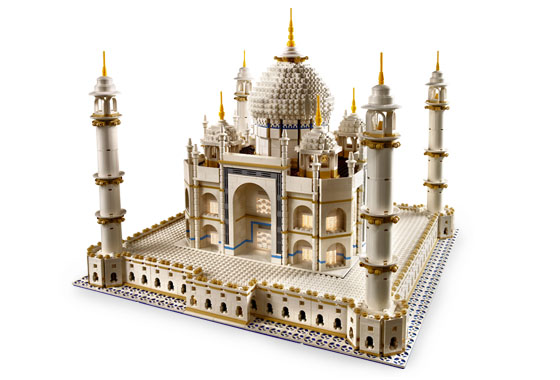
While the Taj Mahal is not a temple or church, it is a mausoleum built for Mumtaz Mahal, the favorite wife of Mughal emperor Shah Jahan, in an Islamic tradition and, for instance, includes verses from the Koran as part of its decoration. Rituals and structures have been intimately linked to faith from tombs in ancient Egypt to European shrines to the saints. If LEGO can make the Taj Mahal a set due to it's architectural and cultural significance, surely they could do the same with something like Notre Dame. I should note that at the Legoland parks there are models of many such landmarks. I'll highlight some of those in future blog posts.
Hints of religion have also been smuggled into a few sets as a more archaeological curiosity. The Ark of the Covenant was the most holy object in ancient Judaism. It carried the stone tablets given to Moses on Sinai and was kept in the innermost chamber of the Temple. Only the high priest could enter this room, and that only on one day of the year. In popular culture, the Ark was at the center of the first Indiana Jones movie. Last year LEGO released a series of Indiana Jones sets, including Indiana Jones and the Lost Tomb. Note the small model of the Ark in the center.
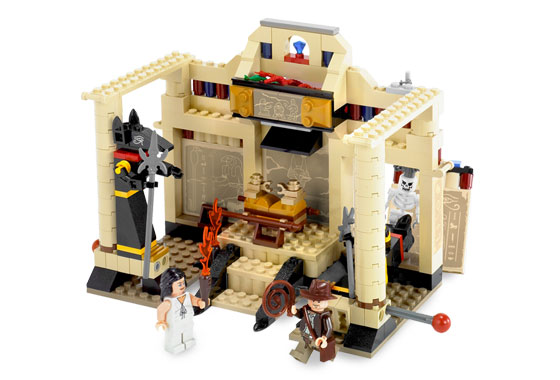
Also note that that set has two statues of Anubis, the god of the afterlife in ancient Egypt. That makes me think that I shouldn't limit myself to the major religions of the current day. With that in mind, before LEGO had a specific license to make official Indiana Jones sets, they had a similar series of sets called the Adventurers. Johnny Thunder (the stand-in for Indy) explored Egyptian ruins in the Desert series, including the Temple of Anubis set shown below.
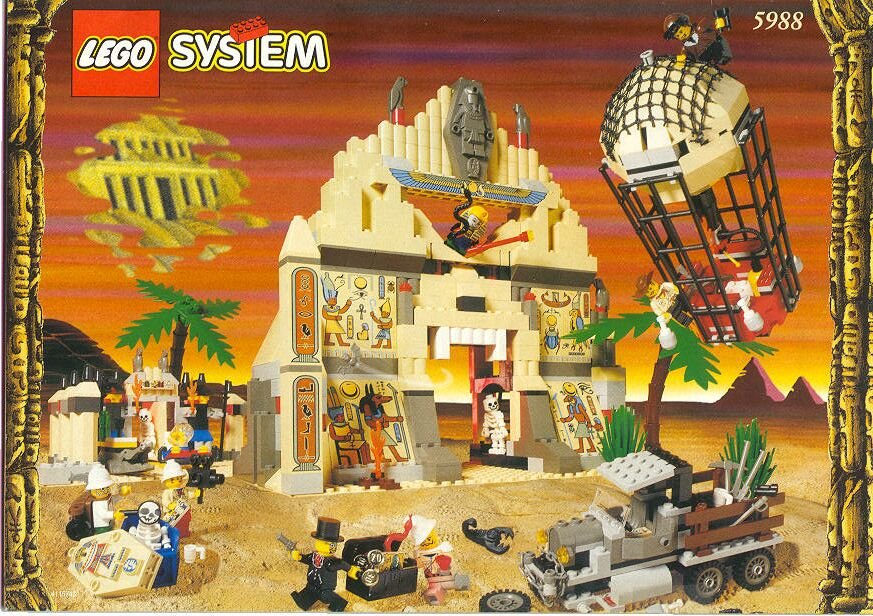
Next Johnny found himself in the jungle, where he found vaguely Aztec/Mayan/Incan/etc ruins in sets like Amazon Ancient Ruins, below. Note, for instance, the headress on the chieftan/priest.
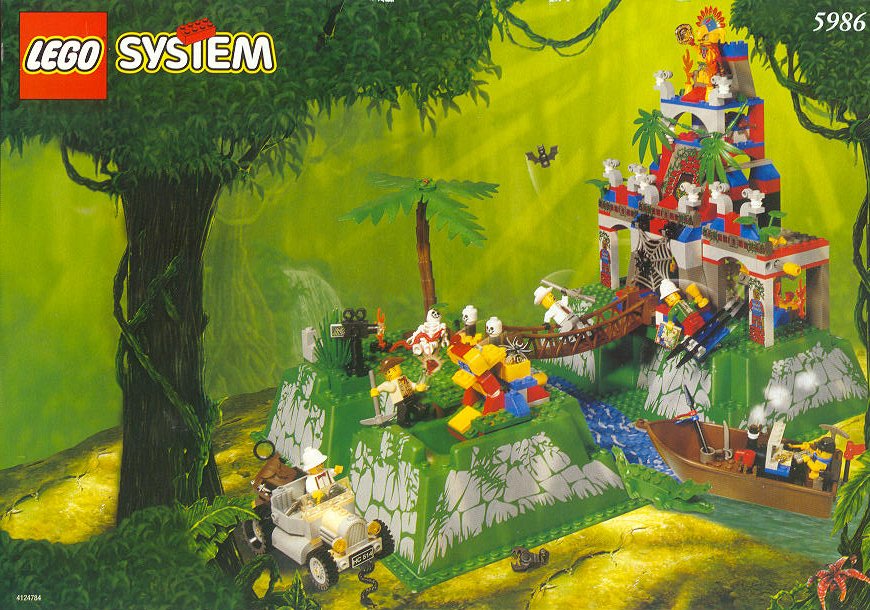
After encountering dinosaurs (no religious content in those sets) Johnny went on an Orient Expedition, where, among other things, he visited the Temple of Mount Everest, below. We'll assume that this is supposed to be Tibetan Buddhist, I guess.
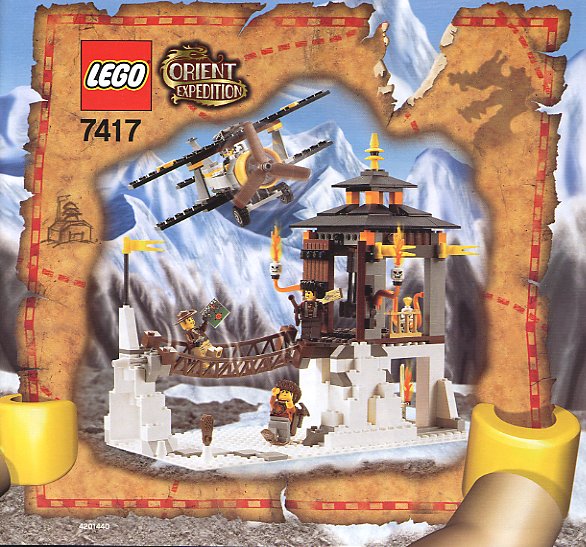
In a separate line, LEGO had pirates sets. A subtheme of that line had the pirates encounter the Islanders in sets such as Enchanted Island. Their religion is totally undefined, but we get a generic idol in that set. I'll assume that it's vaguely based on the Moai of Easter Island.
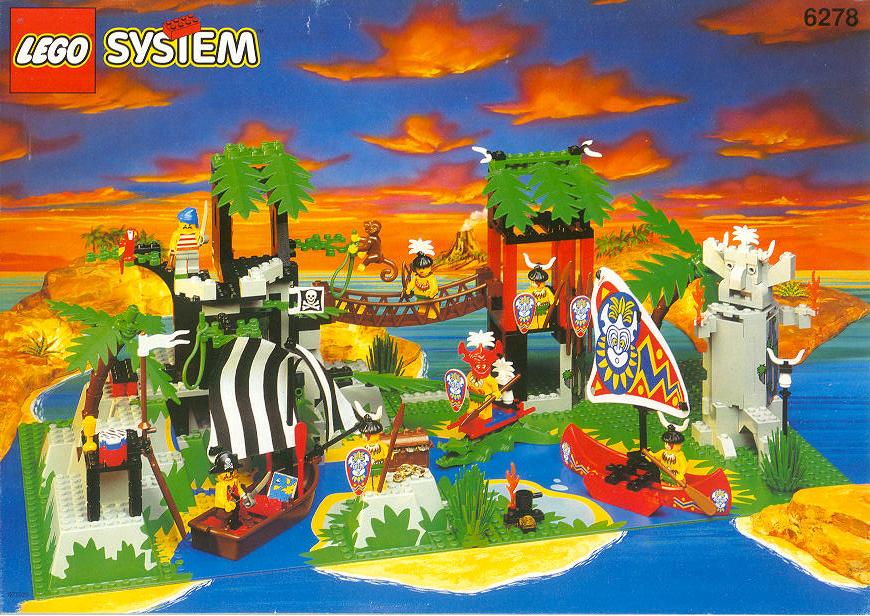
In a comment to a previous discussion of official sets, Brendan correctly pointed out that there have been officials sets based around holidays with religious significance. Christmas is, of course, celebrated by Christians as the commemoration of Christ's birth. Easter is centered on the resurrection of Christ. Thanksgiving involves prayers of praise and thanks. Even Halloween has roots in Catholic tradition (also blending in other traditions). Even though these holidays, and the symbols surrounding them, tie back to religious roots, aspects of their celebration have become more cultural and secular. Most of the sets offered by LEGO really tie to these secular symbols without regard to their background. Perhaps the one that moves beyond the Santa/Reindeer/Bunny/Turkey/Pumpkin line is this angel, first released in 1989 and then rereleased in 2003. Also worth a quick mention, advent calendars have become popular annual sets. Advent is the time leading up to Christmas, taken by many Christians as a time of preparation for the celebration of Christ's birth (as Lent is a preparatory period leading to Easter). About a hundred years ago advent calendars began to be marketed, where a new picture or small gift was revealed each day of December leading up to the big day. The LEGO sets have small LEGO offerings each day, often in a given theme. Last year the news was all about a castle themed calendar, and the rumor is that we will have a pirate calendar this year.

Finally(?), and perhaps not really to be included since this is not a set at all, Luis pointed out these crosses. Before becoming known around the world for little plastic bricks, LEGO made a number of different things. The company started out making wooden toys. After they started molding plastic, it appears that they made some non-toy products as well, including crosses made as custom orders for churches and other groups.
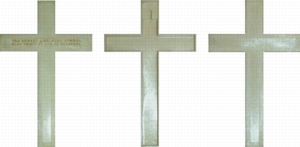
It seems that LEGO has decided to steer clear of official sets touching on religious themes. I suppose this is because they are an international company seeking to sell to people from all different faith communities and do not wish to offend anyone. Personally I think that's sad - faith is such an important part of the human experience and has had such a prominent role in the development of societies that it seems a glaring lack in, say, their Town, Castle, and Wild West themes. This hasn't always been so. Back in 1957 and 1958 they released two sets, both called "church" or "kirche", 309 and 1309. These are pretty much the same set, except in one the printed brick says "1762" and in the other it says either "ANNO 1762" or "AD 1762". The construction is pretty simplistic and so these sets probably would not be of interest to the modern LEGO fan, except maybe for the square windows and old-style trees that haven't been produced in 30+ years. I can't find any significance to the year 1762. Does anyone have a clue to this? Maybe there is a prominent church in Denmark that was built in that year?

The one way that LEGO may get over their avoidance of religious themes is to go with architecturally significant landmarks that have huge cultural importance in addition to a religious sense. One such is the recent Taj Mahal set.

While the Taj Mahal is not a temple or church, it is a mausoleum built for Mumtaz Mahal, the favorite wife of Mughal emperor Shah Jahan, in an Islamic tradition and, for instance, includes verses from the Koran as part of its decoration. Rituals and structures have been intimately linked to faith from tombs in ancient Egypt to European shrines to the saints. If LEGO can make the Taj Mahal a set due to it's architectural and cultural significance, surely they could do the same with something like Notre Dame. I should note that at the Legoland parks there are models of many such landmarks. I'll highlight some of those in future blog posts.
Hints of religion have also been smuggled into a few sets as a more archaeological curiosity. The Ark of the Covenant was the most holy object in ancient Judaism. It carried the stone tablets given to Moses on Sinai and was kept in the innermost chamber of the Temple. Only the high priest could enter this room, and that only on one day of the year. In popular culture, the Ark was at the center of the first Indiana Jones movie. Last year LEGO released a series of Indiana Jones sets, including Indiana Jones and the Lost Tomb. Note the small model of the Ark in the center.

Also note that that set has two statues of Anubis, the god of the afterlife in ancient Egypt. That makes me think that I shouldn't limit myself to the major religions of the current day. With that in mind, before LEGO had a specific license to make official Indiana Jones sets, they had a similar series of sets called the Adventurers. Johnny Thunder (the stand-in for Indy) explored Egyptian ruins in the Desert series, including the Temple of Anubis set shown below.

Next Johnny found himself in the jungle, where he found vaguely Aztec/Mayan/Incan/etc ruins in sets like Amazon Ancient Ruins, below. Note, for instance, the headress on the chieftan/priest.

After encountering dinosaurs (no religious content in those sets) Johnny went on an Orient Expedition, where, among other things, he visited the Temple of Mount Everest, below. We'll assume that this is supposed to be Tibetan Buddhist, I guess.

In a separate line, LEGO had pirates sets. A subtheme of that line had the pirates encounter the Islanders in sets such as Enchanted Island. Their religion is totally undefined, but we get a generic idol in that set. I'll assume that it's vaguely based on the Moai of Easter Island.

In a comment to a previous discussion of official sets, Brendan correctly pointed out that there have been officials sets based around holidays with religious significance. Christmas is, of course, celebrated by Christians as the commemoration of Christ's birth. Easter is centered on the resurrection of Christ. Thanksgiving involves prayers of praise and thanks. Even Halloween has roots in Catholic tradition (also blending in other traditions). Even though these holidays, and the symbols surrounding them, tie back to religious roots, aspects of their celebration have become more cultural and secular. Most of the sets offered by LEGO really tie to these secular symbols without regard to their background. Perhaps the one that moves beyond the Santa/Reindeer/Bunny/Turkey/Pumpkin line is this angel, first released in 1989 and then rereleased in 2003. Also worth a quick mention, advent calendars have become popular annual sets. Advent is the time leading up to Christmas, taken by many Christians as a time of preparation for the celebration of Christ's birth (as Lent is a preparatory period leading to Easter). About a hundred years ago advent calendars began to be marketed, where a new picture or small gift was revealed each day of December leading up to the big day. The LEGO sets have small LEGO offerings each day, often in a given theme. Last year the news was all about a castle themed calendar, and the rumor is that we will have a pirate calendar this year.

Finally(?), and perhaps not really to be included since this is not a set at all, Luis pointed out these crosses. Before becoming known around the world for little plastic bricks, LEGO made a number of different things. The company started out making wooden toys. After they started molding plastic, it appears that they made some non-toy products as well, including crosses made as custom orders for churches and other groups.

Thursday, May 21, 2009
Still more official sets
In commenting on my previous post on official LEGO sets with religious content, Brendan correctly pointed out that there have been officials sets based around holidays with religious significance. Christmas is, of course, celebrated by Christians as the commemoration of Christ's birth. Easter is centered on the resurrection of Christ. Thanksgiving involves prayers of praise and thanks. Even Halloween has roots in Catholic tradition (also blending in other traditions). Even though these holidays, and the symbols surrounding them, tie back to religious roots, aspects of their celebration have become more cultural and secular. Most of the sets offered by LEGO really tie to these secular symbols without regard to their background. Perhaps the one that moves beyond the Santa/Reindeer/Bunny/Turkey/Pumpkin line is this angel, first released in 1989 and then rereleased in 2003. Also worth a quick mention, advent calendars have become popular annual sets. Advent is the time leading up to Christmas, taken by many Christians as a time of preparation for the celebration of Christ's birth (as Lent is a preparatory period leading to Easter). About a hundred years ago advent calendars began to be marketed, where a new picture or small gift was revealed each day of December leading up to the big day. The LEGO sets have small LEGO offerings each day, often in a given theme. Last year the news was all about a castle themed calendar, and the rumor is that we will have a pirate calendar this year.


Wednesday, May 20, 2009
Virgen de Guadalupe
In 1531, so the story goes, the Virgin Mary appeared in a vision to Juan Diego on a road near Mexico City. An image of her was left on Juan's cloak, and this cloak is still kept in the Basilica of Guadalupe. Mexican Catholics see the Virgin of Guadalupe as a special protector of their nation and will go on pilgrimages to see this icon. Bruceywan (not me, another AFOL) came up with a LEGO version of the traditional depiction of the Virgin. Thanks to Brendan Powell Smith for the heads-up.
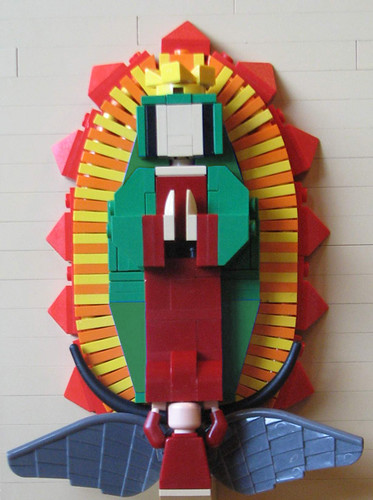

Tuesday, May 19, 2009
Swiss guards
If you've been to the Vatican, you've noticed guards in somewhat fanciful uniforms. Look close, though, and you can tell that these are soldiers you don't want to mess with. Over the last 500 years, Swiss soldiers have served as mercenary units around Europe. The last remaining regiment is in Rome, where they have served since the time of Pope Sixtus IV in the late 15th century. They carry traditional weapons like swords and halberds, but are actually highly skilled modern soldiers ready to act as the bodyguards to the Pope. I haven't seen the movie Angels and Demons yet, but I guess they must play a role, as they inspired Sir Nadroj to make Swiss Guard minifigs.
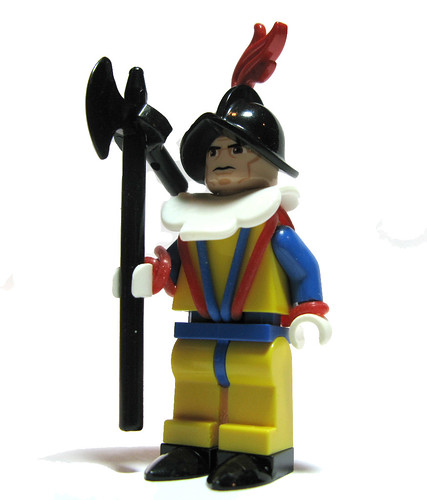
Swiss Guards are Catholic Swiss nationals who have completed training in the Swiss army before applying to the Vatican. Their oath of office is:

Swiss Guards are Catholic Swiss nationals who have completed training in the Swiss army before applying to the Vatican. Their oath of office is:
"I vow to faithfully, honestly and honorably serve the reigning Pope [name of Pope] and his legitimate successors, and to dedicate myself to them with all my strength, ready to sacrifice, should it become necessary, even my own life for them. I likewise assume this promise toward the members of the Sacred College of Cardinals during the period of the Sede Vacante of the Apostolic See. Furthermore, I pledge to the Commandant and to my other superiors respect, fidelity, and obedience. I swear to abide by all the requirements attendant to the dignity of my rank."
Monday, May 18, 2009
Origins?
Erich von Däniken wrote a series of books starting with 1968's Chariots of the Gods claiming that aliens had played a key role in the history of humanity. Among other things, he claimed that aliens were behind ancient religions, visions such as Ezekiel's, and the construction of ancient monuments. While his ideas have been generally dismissed by scholars, they have taken some hold in popular culture, providing the background for many science fiction pieces (think, for instance, of the end of the most recent Indiana Jones movie). Perhaps a little more respect is given to the idea of panspermia, that life on earth may have originated elsewhere. Sir Nadroj played with the idea of alien influence at the very start of things in Cogs of the Gods. I know it's a bit of a stretch to include this MOC on this blog, but I figured we can have some fun with the topic here. Perhaps something more serious tomorrow.

Origins

Origins
Sunday, May 17, 2009
Scriptorium
I hope it's not too self-indulgent to present one of my own creations. As described in part in How the Irish Saved Civilization, among many other places, medieval monks played a key role in preserving texts, both religious and otherwise, by hand-copying them. I've said before that that (or alchemist) would be my job if I had lived during that time, and my sig-fig is the Precentor of the Scriptorium.
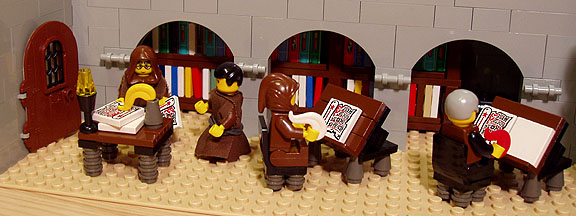
A scriptorium was a large room in a monastery used by the scribes and copyists for copying books by hand. Some monks had specialties: those who copied books were called antiquarii, those who dealt with daily business were called librarii or scriptores, those who added illustrations to the margins of text were known as illuminators, and a specialist in legal documents was called a notarius. These were all supervised by the precentor and his assistant the amarius. source

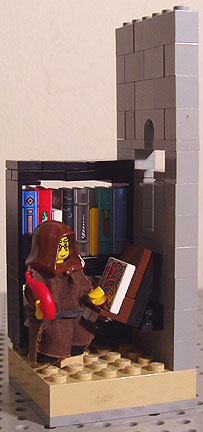

A scriptorium was a large room in a monastery used by the scribes and copyists for copying books by hand. Some monks had specialties: those who copied books were called antiquarii, those who dealt with daily business were called librarii or scriptores, those who added illustrations to the margins of text were known as illuminators, and a specialist in legal documents was called a notarius. These were all supervised by the precentor and his assistant the amarius. source


Friday, May 15, 2009
Ganesh
Ganesh is one of the major deities of the Hindu pantheon. His image is found throughout Indian art and even has appeared on the Simpsons a few times (Apu has a statue of Ganesh in the Kwik-E-Mart that Homer offered a peanut, plus the Simpson children once dressed up as Ganesh). According to the Wikipedia entry, he is the Lord of Beginnings and Lord of Obstacles, patron of arts and sciences, and the deva of intellect and wisdom. Moose Greebles made a LEGO version of Ganesh for a History of Non-Western Art class.

Thanks to Lt. Col. Thorin for the heads-up on this, and a reminder to anyone to let me know of relevant LEGO creations you see out there. Just drop me a note at bricktalesATgmailDOTcom. Thanks!

Thanks to Lt. Col. Thorin for the heads-up on this, and a reminder to anyone to let me know of relevant LEGO creations you see out there. Just drop me a note at bricktalesATgmailDOTcom. Thanks!
Wednesday, May 13, 2009
Solomon's Temple
For four centuries Solomon's Temple was the center of religious life in ancient Israel. This building housed the holiest relic, the Ark of the Covenant, and was the location for sacrifices to God and other religious rites. This first Temple replaced the mobile Tabernacle that was carried by the Israelites in their years in the desert and then was the center of worship in the promised land. 1 Kings 6 describes how Solomon built it in about 960 BCE. It was destroyed by invading Babylonians in 586 BCE, to be rebuilt 70 years later by Israelites returning from exile. Some believe that the Temple will be rebuilt again at the initiation of a Messianic age. Thomas, aka tbone tbl, assembled a LEGO version of Solomon's Temple in what can only be described as an act of love. He spent 13 months on this project, as recounted on his blog.

Now the outside is not all that interesting, but Thomas can hardly be blamed for that as he faithfully recreated the structure as commonly described. The interesting parts, though, are the interior:

and all of the Temple furnishings (described in 1 Kings 7). I particularly like the sea supported by 12 golden bulls:

and this very simple yet effective Ark of the Covenant:

Thomas also made some really nice sheep and a custom priest figure, so I'm hoping that he'll set up various scenes showing the life of the Temple and various events that happened there.


Now the outside is not all that interesting, but Thomas can hardly be blamed for that as he faithfully recreated the structure as commonly described. The interesting parts, though, are the interior:

and all of the Temple furnishings (described in 1 Kings 7). I particularly like the sea supported by 12 golden bulls:

and this very simple yet effective Ark of the Covenant:

Thomas also made some really nice sheep and a custom priest figure, so I'm hoping that he'll set up various scenes showing the life of the Temple and various events that happened there.

Tuesday, May 5, 2009
Thích Quảng Đức
In addition to inspiring art and architecture, religious faith has been a point of conflict throughout history. In 1963, South Vietnam was primarily a Buddhist nation, but the government was controlled by a Catholic minority. In protest of persecution of Buddhists and preferential treatment of Catholics, a Buddhist monk named Thích Quảng Đức lit himself on fire in front of crowds of onlookers. He became a symbol of compassion to Vietnamese Buddhists and is considered by them to be a bodhisattva, or enlightened one. The Pulitzer-prize-winning photo of the event was recreated in LEGO by Balakov, or Mike Stimpson.


Sunday, May 3, 2009
When in Rome ...
Arthur Gugick is one of my favorite builders when it comes to architectural landmarks. He's built a ton of these at various scales. Of course, the world's architectural landmarks are often religious structures, such as his Saint Peter's Basilica. Saint Peter's is, of course, the main cathedral in Roman Catholicism. It is the heart of the Vatican, where the Pope presides over services on major holidays. Tradition holds that the crypt beneath the altar holds the remains of Peter, one of the twelve disciples of Jesus and the first bishop of Rome.


Saturday, May 2, 2009
Yungang Grottoes
The Yungang Grottoes are a significant ancient sculptural site in the Shi Li river valley in China. More than 51,000 statues of Buddha were carved into the walls of a series of 252 grottoes between 460 and 525 AD. Chinese LEGO fan Tiger0207 built a LEGO version
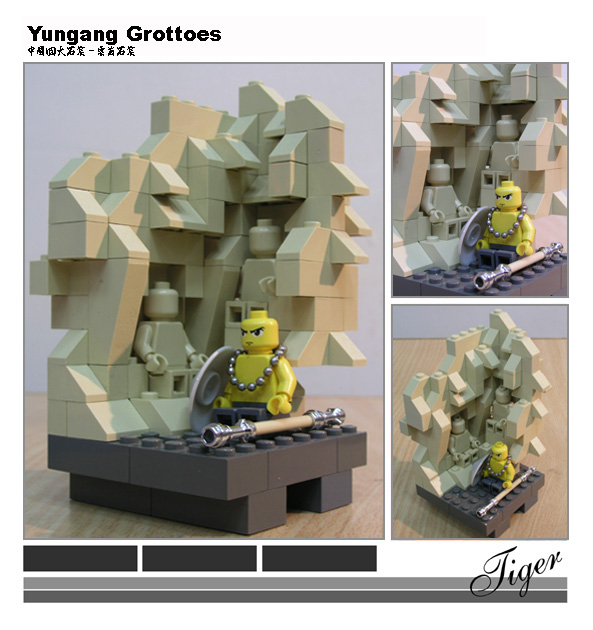

Subscribe to:
Comments (Atom)